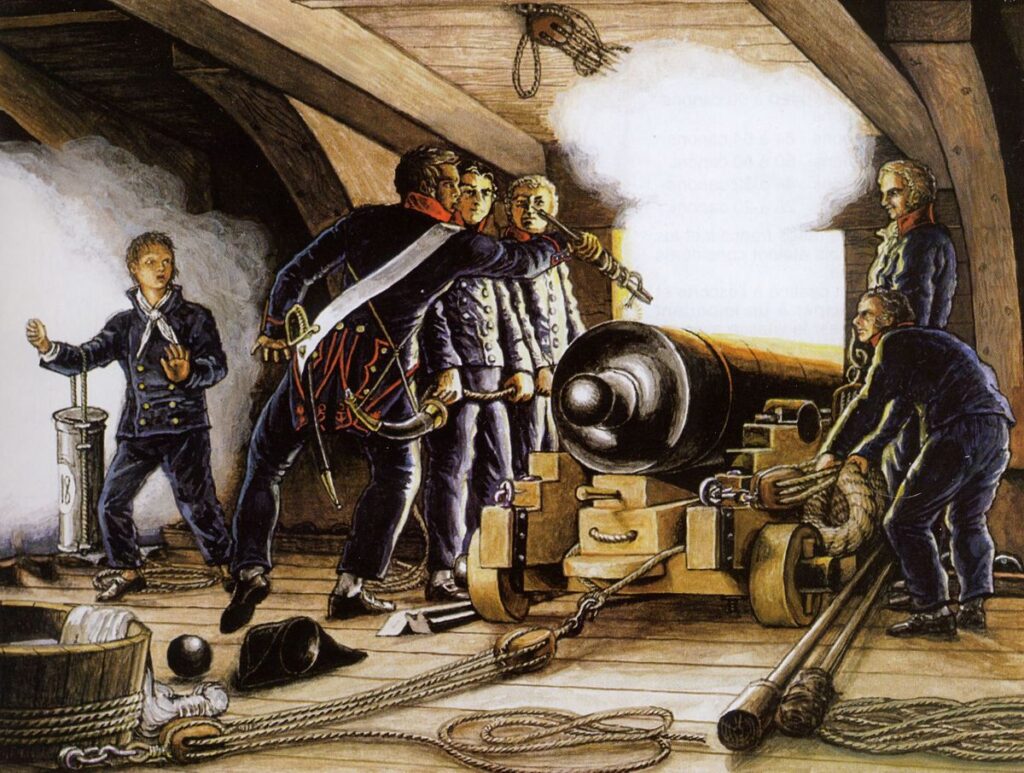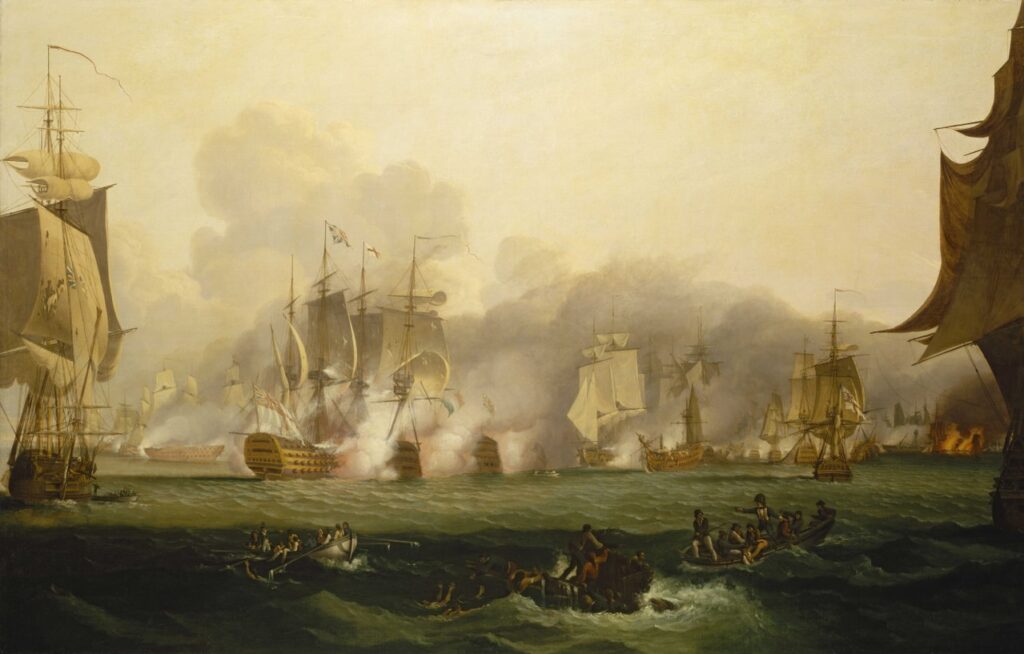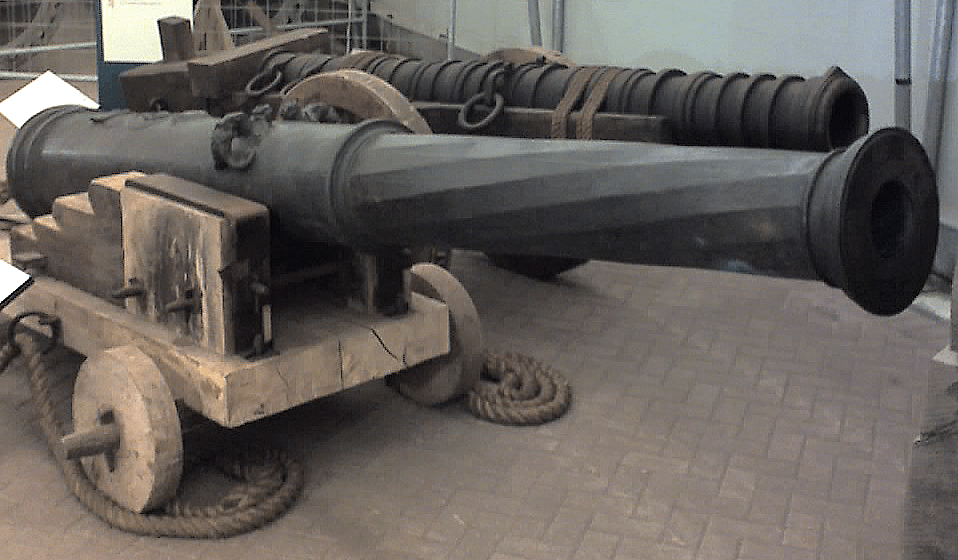Naval warfare has undergone tremendous transformations over time. One of the most significant developments in naval warfare was the evolution of naval cannon balls.
These projectiles, fired from powerful ship cannons, played a critical role in battles at sea. In this article, we will explore the design, usage, and evolution of naval cannon balls, along with the different types of balls used in naval warfare.
- The Early Days of Naval Cannon Balls
- The Size and Weight of Naval Cannon Balls
- Ship Cannons
- Cannon Types
- The Ships Gun Crew
- Types of Cannonballs
- Naval Cannon Balls in Action
- Cannon Ball Range
- Firing Their Last
The Early Days of Naval Cannon Balls
Naval cannon balls have been used since ancient times. The earliest cannons were small, and their balls were made of stone or iron. These early cannon balls were highly inaccurate and often failed to penetrate the thick wooden hulls of enemy ships.

The first significant improvement in naval cannon balls came in the 16th century with the invention of the iron cannonball. These balls were heavier than their stone counterparts and were more accurate when fired. However, they still lacked the power needed to penetrate thick wooden hulls.
The Size and Weight of Naval Cannon Balls
Naval cannon balls came in various sizes and weights. The size and weight of the ball depended on the type of cannon that fired it. Here is a look at the most common sizes and weights of naval cannon balls:
- 6-pounder ball – This ball weighed around 6 pounds and was fired from a 6-pound cannon.
- 9-pounder ball – This ball weighed around 9 pounds and was fired from a 9-pound cannon.
- 12-pounder ball – This ball weighed around 12 pounds and was fired from a 12-pound cannon.
- 18-pounder ball – This ball weighed around 18 pounds and was fired from an 18-pound cannon.
- 24-pounder ball – This ball weighed around 24 pounds and was fired from a 24-pound cannon.
- 32-pounder ball – This ball weighed around 32 pounds and was fired from a 32-pound cannon.
Ship Cannons
Naval cannon balls were fired from ship cannons, and the crews responsible for operating these cannons were critical to the success of naval battles. The size of the ship determined the size and number of cannons that it could carry.
The largest ships, like the line of battleships, could carry up to 100 or more cannons, while smaller ships, like frigates, would carry between 20 and 40 cannons.

Ships cannons were typically made of cast iron or bronze and were designed to be mounted on swivel gun carriages or fixed gun carriages. The size and weight of the cannon varied depending on its purpose and the size of the ship it was mounted on.
Read More: Mysterious Wreck off English Coast Identified as Historic Dutch Warship
Cannons were typically classified based on their “poundage,” which referred to the weight of the cannonball that the cannon could fire. For example, a 12-pounder cannon could fire a cannonball weighing 12 pounds.
Cannon Types
There were several different types of ships cannons used during the Age of Sail, each with its own specific purpose. Some of the most common types of cannons included:
Carronade: The carronade was a short-barrelled, large- calibre cannon that was popular during the late 18th and early 19th centuries. It was designed to fire a large, heavy cannonball at close range, and was effective at inflicting damage to an enemy ship’s hull.
Read More: WW2 Shipwreck: Time to Remove 1400 Tons of Explosives
Long Gun: The long gun was a longer, more narrow cannon that was designed to fire a smaller, lighter cannonball at longer ranges. It was typically used for long-range engagements, and was often mounted on the upper decks of ships.
Swivel Gun: The swivel gun was a small, lightweight cannon that was mounted on a swivel gun carriage. This allowed it to be easily aimed in any direction. It was typically used for close-range engagements, and was effective at repelling boarders or attacking small boats.
The Ships Gun Crew
The crew responsible for operating the cannon consisted of several men. These were primarily the gunner, the loader, the sponger, and the powder monkey.
The gunner was responsible for aiming and firing the cannon, while the loader was responsible for loading the cannon with the appropriate type of cannon ball.

The sponger was responsible for cleaning the cannon between shots, and the powder monkey was responsible for carrying the gunpowder to the cannon.
A naval cannon gun crew typically consisted of between six and ten men, depending on the size of the cannon. The crew was led by the gun captain, who was responsible for giving orders and ensuring that the crew worked together efficiently.
Loading the Cannon
Loading the cannon was a complex process that required careful coordination and precision. The first step was to prepare the cannon by cleaning it and applying lubricant to the bore. This helped to prevent fouling and made it easier to load the cannon.
Read More: Civil War Cannonball Found in River & it Was Live
The gun captain would then give the order to load the cannon. The gunner would place a charge bag with the appropriate amount of gunpowder and put it into the cannon’s barrel. In older cannons this was poured in and a wad of paper or cloth used hold the powder in place.

Next, the loader would insert the cannonball into the cannon’s muzzle, using a special tool called a “rammer” to push it down the bore.
Finally, the gun captain would give the order to “prime” the cannon. The gunner would use a small amount of gunpowder to create a spark that would ignite the main charge of powder inside the cannon. The cannon was now ready to be fired.
Firing the Cannon
Firing the cannon was a dangerous and physically demanding task that required strength and agility. The gun crew had to work quickly to load and fire the cannon, while avoiding the recoil of the gun.
When the gun captain gave the order to fire, the gunner would apply a lighted match or friction primer to the touchhole of the cannon. This would ignite the powder inside the chamber and propel the cannonball out of the muzzle at high speed.
The recoil of the gun was significant and could cause serious injury or even death if the gun crew was not careful. The gun crew had to stand clear of the recoil and be ready to quickly load the cannon again if necessary.

When this was done and the cannon fired, the sponger would then use a wet sponge to clean the inside of the bore and extinguish any remaining embers or sparks. Th process was then repeated.
Overall, the naval cannon gun crew played a crucial role in the success of naval warfare during the Age of Sail. Their expertise and skill were essential for operating the powerful cannons that could turn the tide of a battle.
Types of Cannonballs
Naval cannons fired a variety of different types of cannonballs that were designed for specific purposes, such as penetrating the hull of an enemy ship or setting it on fire.
The gun crew had to select the appropriate type of cannonball for the situation and load it carefully into the cannon.
Read More: Medal Given to Battle of Trafalgar Hero Aged ELEVEN Auctioned for £15,000
Some of the most common types of cannonballs included:
Round Shot: Round shot was a solid iron ball that was fired from the cannon. It was designed to penetrate the hull of an enemy ship and cause damage to its internal structure.
Grapeshot: Grapeshot was a type of cannonball that was made up of multiple smaller balls, like a giant shotgun shell. It was designed to be fired at close range and could inflict serious damage to an enemy ship’s crew.

Chain Shot: Chain shot was a type of cannonball that was made up of two balls connected by a chain. It was designed to be fired at the enemy ship’s rigging, in an attempt to disable its masts and sails.
Shell: Shell was a type of cannonball that contained explosive powder. It was designed to explode on impact with the enemy ship, causing significant damage.
Hot Shot: Hot shot was a type of cannonball that was heated red-hot before being fired from the cannon. It was designed to set enemy ships on fire and cause horrific fires and damage.
Naval Cannon Balls in Action
Naval cannon balls played a critical role in many famous naval battles throughout history. One such battle was the Battle of Trafalgar, which took place on October 21, 1805, off the coast of Spain. The battle was fought between the Royal Navy of the British and the combined fleets of France and Spain.
During the battle, the British used a combination of round shot and grape shot to devastating effect. These round shot were used to damage the enemy ships’ hulls and rigging, while the grape shot was used to clear the decks of enemy crews.
The British victory at the Battle of Trafalgar was largely due to their superior use of naval cannon balls.

The naval cannon gun crew was a critical component of naval warfare during the Age of Sail. These skilled men were responsible for operating the powerful cannons that could decide the outcome of a battle.
Loading and firing the cannon was a complex and dangerous process that required precision and coordination. The gun crew had to work together as a team to load the cannon quickly and fire it accurately, while avoiding trapping fingers and limbs.
How far did cannon balls fly?
Cannon balls’ distance varied based on the type of cannon and the angle at which they were fired. In general, during the 18th and 19th centuries, a cannon ball from a large cannon could fly a distance of up to several miles.
However, the most effective range, where they could do the most damage, was usually much shorter. The size of the cannon, the weight of the ball, and the amount of gunpowder used all influenced the distance. So, while they could travel far, the exact distance depended on many factors.
Firing Their Last
Naval cannon balls played a critical role in naval warfare throughout history. The evolution of naval cannon balls from stone and iron balls to the more sophisticated shells and hot shot allowed naval commanders to inflict significant damage on their enemies.
Read More: Civil War Cannonball Found in River & it Was Live
The different types of naval cannon balls, including round shot, grape shot, chain shot, shell, and hot shot, gave commanders a variety of tactical options depending on the situation.
Ship cannons and their crews were equally critical to the success of naval battles. The size and number of cannons on a ship were determined by its size, and the crew responsible for operating the cannons were skilled and highly trained.
Naval cannon balls were used in some of the most famous naval battles in history, including the Battle of Trafalgar and The Spanish Armada. These battles demonstrated the devastating power of naval cannon balls and the importance of their strategic use in naval warfare.
Read More: WWII Ammunition Dump Explodes in Berlin’s Grunewald Forest
In conclusion, naval cannon balls were an essential component of naval warfare throughout history. They allowed commanders to inflict significant damage on their enemies and played a critical role in the outcome of many famous naval battles.







